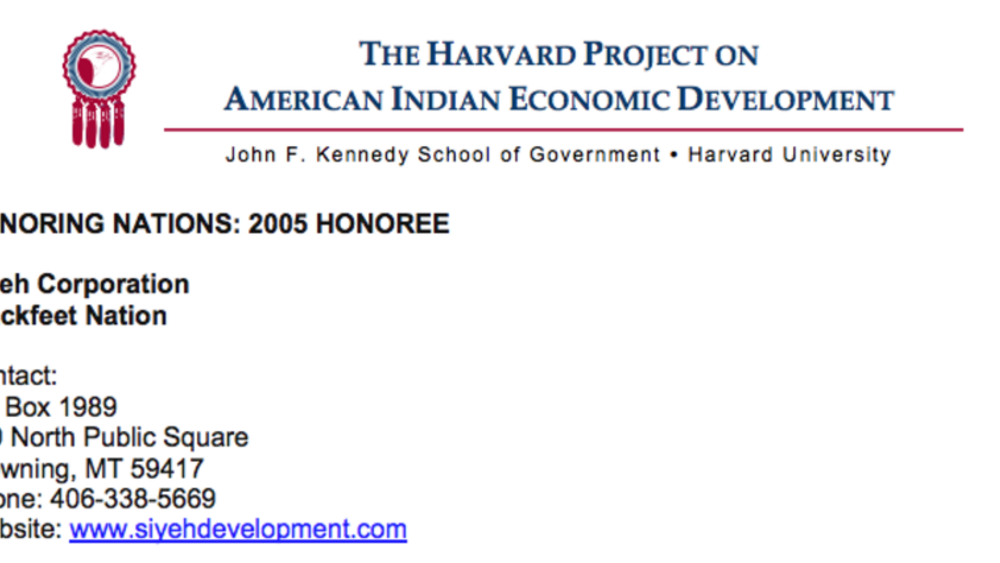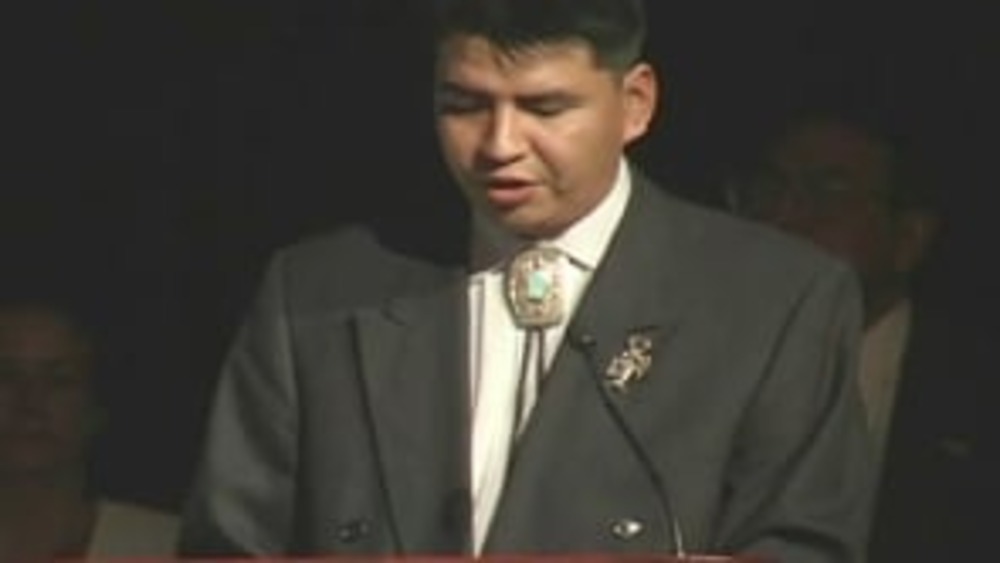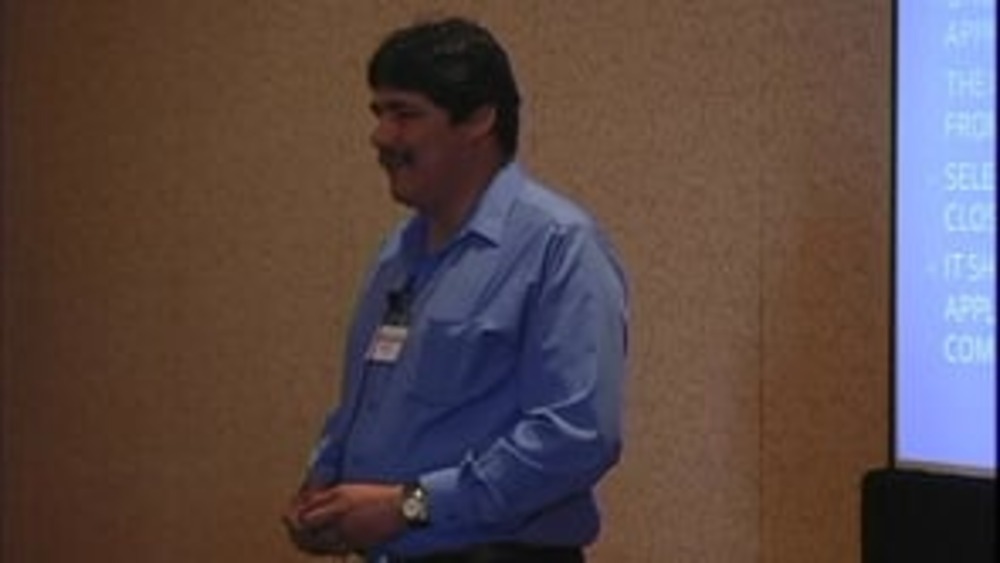Representatives from the Siyeh Corporation present an overview of the corporation's establishment and growth to the Honoring Nations Board of Governors in conjunction with the 2005 Honoring Nations Awards.
Additional Information
Bird Rattler, Loren, Ray Montoya, and Jay St. Goddard. "Siyeh Corporation." Honoring Nations Awards event. Harvard Project on American Indian Economic Development, John F. Kennedy School of Government, Harvard University. Tulsa, Oklahoma. November 1, 2005. Presentation.
Transcript
Loren Bird Rattler:
"Thank you, Amy. As she mentioned, my name is Loren Bird Rattler. I'm the Manager of the Blackfeet Heritage Center and Art Gallery, a business line of the parent company Siyeh Corporation. I would like to first thank the Harvard Project on American Indian Economic Development for allowing us a forum to certainly showcase our successes that we've had at Siyeh Corporation back in Blackfeet Country.
With that said, I'd like to begin with the question, 'Why was Siyeh Corporation created?' First, a legal enterprise was needed to develop and operate business opportunities for the Blackfeet Tribe. This enterprise needed to be a for-profit entity that would provide an alternative source of revenue for the Blackfeet Tribe as well as create a source of revenue...I'm sorry, a source of revenue for the Blackfeet Tribe as well as create additional jobs for the local economy. But more specifically, it was to create an enterprise whose day-to-day business decisions and practices were separate from tribal politics and decision making. This process happened in four phases: analysis and bench marketing, petitioning the Secretary of Interior, the approval of that petition, and finally ratification by the Blackfeet Tribe.
In 1997 the Blackfeet Planning Department began to script plans for a for-profit company that would be semi-autonomous from tribal political influence and decision-making. The Planning Department embraced a new paradigm of thinking that would change the dynamic of how the Blackfeet Tribe would and could create and sustain profitable businesses. The first task was an analysis on the approach to economic development on the Blackfeet Reservation. During this analysis, the Planning Department began to benchmark other tribes to find out what types of infrastructure they were using in tribal enterprises and businesses. From this analysis, a new comprehensive economic development strategy was put in place to create a for-profit corporation. Many of the principles were taken directly from the concepts of 'Reloading the Dice, Improving Economic Development on American Indian Reservations,' which was found in the publication American Indian Economic Development from the Harvard Project on American Indian Economic Development.
In early 1999 the Planning Department drafted the corporate charter for Siyeh Corporation under the framework of Section 17 of the Indian Reorganization Act of 1934. Upon completion of the draft, the Blackfeet Tribal Business Council passed resolution number 10899 and shortly thereafter petitioned the Secretary of Interior. Upon approval of the petition by the Deputy Commissioner of Indian Affairs on July 8th, 1999, the proposal was sent back to the Blackfeet Tribe for ratification. During this time, a new council had been elected and inaugurated and a referendum was passed changing the structure of terms for the council from two-year terms to staggered four-year terms. Of course this created a new problem for Siyeh. We had to re-lobby a new council, that some of them serving two years, some of them serving four years in 2000. After this lobbying effort was launched, we were able to convince the Chairman of the Blackfeet Tribal Business Council and therefore get the rest of the council on board. After that happened, of course the charter was ratified on January 3rd, 2001. Because of the language of Section 17 of the Indian Reorganization Act, once ratified by the tribe, it requires an act of Congress to dissolve, further limiting potential influence or potential political influence.
From the drafting of the charter to present day, Siyeh Corporation has and will continue to have struggles. In the beginning, it was very difficult getting local businessmen to serve on the board of directors simply because of the mistrust toward tribal enterprises following a number of failed business ventures. The tribal government and to a greater extent the Blackfeet Tribal Business Council's role is continually being defined and redefined with every incoming council. In the very beginning of course, there was problems with a lack of funding to get the corporation off the ground. The struggle with public perception and the old political philosophy that the Blackfeet Tribal Business Council should have the final say on all matters coupled with Siyeh Corporation's approach to problem solving presents a public relations challenge that Siyeh Corporation continues to address and remedy today.
Siyeh Corporation has five successful business lines. In 1999, the Blackfeet Tribe acquired Starling Cable Company, which was in jeopardy of losing programming. The company has increased subscriptions and offers a public access channel for community programming. In April 2000, under the threat of closure from the National Indian Gaming Commission, Siyeh inherited the Glacier Peaks Casino in Browning. Glacier Peaks Casino now operates seven days a week with exceptional revenue. Kimmie Water was created in late 2000 to deliver five-gallon water jugs to the community due to the poor quality of water with the present water system that exists on the reservation. And in 2002, Discovery Lodge Casino was created to tap into the eastern reservation gaming market. And finally, in mid-2002 with the acquisition of the inventory from the Northern Plains Arts Cooperative, Siyeh Corporation created the Blackfeet Heritage Center and Art Gallery. The center provides an outlet for local artists, artisans, and crafts people to market their work as well as advocate through programming Blackfeet cultural and traditional preservation.
Currently, there are four future projects that are being developed under Siyeh Corporation. A grocery store has surpassed its planning stage and now has a site as well as a distributor identified. The design for the store has been completed. An expansion to the Glacier Peaks Casino is underway. Construction began on a new 30,000-square-foot facility that will house 300-plus class two gaming machines, a 250-seat Bingo hall and a restaurant, lounge and gift shop. Plans have just got underway for a wireless internet business that will bring wireless internet service to rural residents of the Blackfeet Reservation. A feasibility study and business plan are now underway. Siyeh Corporation has completed an SBA 80 application that will aid in marketing Kimmie Water and integrated information technology services and solutions. It may also help with future federal contracting.
Siyeh Corporation has been instrumental in the development of the local economy. In 2004, Siyeh's five business lines paid out over one million dollars in payroll and disbursed $963,173 in dividends to corporate shareholders, the Blackfeet Tribe. Siyeh assets in the year 2000 were around $300,000 compared to nearly $800,000 today. These assets include real property, equipment, vehicles and inventory. Vicariously through its business lines, Siyeh Corporation aids in community development. By providing bottled water to community members, elders and diabetics, Kimmie Water provides a necessary resource that was lacking before. Starling Cable Television, through its community access channel number 37, provides local programming, including Blackfeet Tribal Business Council meetings, public forums, high school sports, and Blackfeet cultural and educational programming. Siyeh also helps with the cultural preservation by purchasing, marketing and exposing Blackfeet artists, artisans and crafts peoples' work. This practice in turn will allow the Blackfeet Heritage Center and Art Gallery to conduct educational workshops on traditional artistic practices. This venue, which includes Blackfeet culture and history teaches both non-Natives as well as our own youth about ourselves.
Siyeh Corporation was named after the Blackfeet warrior Siyeh or Mad Wolf. The spirit of Siyeh in the telling of tribal elders embodies independent thinking, shouldering responsibility for the work that has to be done, and taking bold action. Because of this inspiration, Siyeh Corporation will continue in its efforts to span strategically while protecting the environment, culture and tradition and will continue to be fearless, independent and true, as their motto states."
Alfreda Mitre:
"Congratulations. I had formulated three questions and during your presentation you answered all three of them, so I'll just take this time and say thank you for a wonderful presentation and I'll let the others if they have any questions to go ahead and do so."
Loren Bird Rattler:
"Thank you."
Elsie Meeks:
"So I would imagine that this was fairly controversial in incorporating a Section 17 corporation."
Loren Bird Rattler:
"Yes, it was."
Elsie Meeks:
"Well, that's an issue that I think a lot of tribes would struggle with. I guess if you could talk a little bit more about the reason that you decided to do that, because I know that that must have been a hard decision for you all to make but there must have been a good reason why you did it, and I'd just like you to expand on that a little bit because I think there's some good lessons here."
Loren Bird Rattler:
"Certainly and I'll defer that question to the economic development coordinator Ray Montoya."
Ray Montoya:
"Okay, I'll try to shed a little light on that question. One of the reasons we went with a federally chartered corporation was because in the past and up to that point in time most of the businesses were under the auspices of the Blackfeet Tribal Business Council directly under tribal government and unfortunately under that structure the Blackfeet Tribe hasn't had one successful business as a tribal-owned business directly under the tribal government. And so we saw this as a way of changing that lack of success and then allowing a business to grow as it should without the lack of governmental interference."
Brian C. McK. Henderson:
"I would like to ask a follow-up question. You've basically created what in effect is a tribal holding company with a variety of different businesses underneath this one structure and if you could project out into the future and given the challenges that the tribe actually has in economic development and getting businesses going. Do you see the structure on the...under the Section 17 format helping you in the future or do you see it at some point something that you may want to actually change?"
Jay St. Goddard:
"Speaking on behalf of the Blackfeet Tribal Business Council and the experience I've had as a previous board member on the Siyeh Corporation, it is a model and we expand on it and we want to keep it because it does help us for future businesses and that's one of the main reasons it was put into place. And from past experience and being a leader on the council and knowing what goes on in the political realm and views you get from your membership, I feel it's important it stays in place because it does help our economic future, because changeover in Indian Country as everyone knows happens so regularly and each time there's a change, although we're elected officials, some of them come in thinking they know every answer to economic development or there's that certain money savior out there that's going to come in and save the tribe but that doesn't happen. And with this charter being in place, I think it helps the corporation sustain its ability to prove to the community -- slowly in some ways but fast in other ways -- that this is what we needed in place for a long time, to help us be a successful tribe and business-minded people we have. We have a lot of management people under this corporation that are helping us move these projects along. But it will definitely be a future need and as a tribal leader I hope this would stay in place and it's not taken away, it stays out of the realm of politics. I'm one of the tribal leaders that fight for this corporation every day and help the other tribal leaders understand that this is needed, it's not to be tossed around every time it's brought up to vote it down again. I use that because it's...the charter under the government or wherever it's...however it was created was a great idea. It just makes it harder for a simple motion or resolution for a new council to come in and dissolve this company. That's what'll keep it successful."



